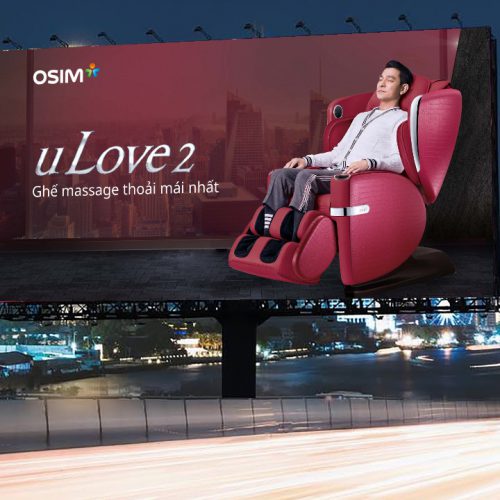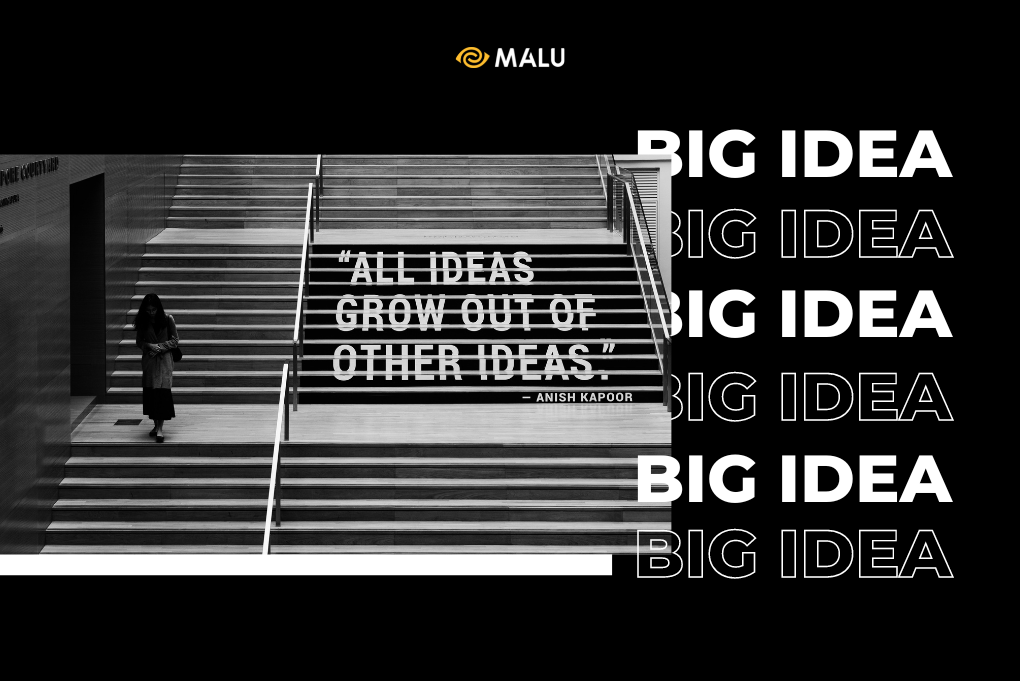
What is Big Idea? What is Big Idea in Marketing? You’ve probably heard the term Big idea somewhere. However, in marketing and advertising, the Big idea represents a key to success in efforts to communicate the business’s brand, products and services. So what is the big idea? Without a clear concept, it is very unlikely that a campaign will generate great buzz and desired attention from the target audience.
Creating a Big Idea is an essential part of the process of building a Marketing campaign. Lack of a clear, weighty and different concept will make the brand lose the opportunity to shine with its target audience.
That’s why Big Idea is not to be missed
The creative release phase seems to be the most “enjoying” time in a marketing campaign. However, the process to create a complete Big Idea can be very difficult.
In today’s article, let’s go with Malu to learn the basic steps to form a Big Idea. As well as specific examples of Big Idea from well-known brands.
What is Big Idea?
The Big Idea is the overarching message that underlies all other elements of the campaign, intended to impress the target audience. Big Idea needs to be rooted in Insight throughout and aligned with campaign goals to ensure it has maximum impact.
The goal is to develop an idea that is linked and integrated with all other relevant channels. Rather than a series of separate, interrelated implementations. This approach will give the brand a stronger position to attract consumers.
>>> See more articles: What is Key Message? How to Build Compelling Communication Messages
Big Idea, Key Message and Insight?
Insight comes from carefully researching and analyzing the characteristics, needs, and desires of the target customer. After gaining insight, the marketer can come up with a marketing strategy, first of all, Big Idea. Big Idea is a general idea, an orientation for all marketing activities for newly found insight. Then comes the key message. Key message is the key message that the brand wants to tell its target customers. This key message needs to be consistent with the previous insight and Big Idea.
How to find an explosive Big Idea – Big Idea in Marketing
1. “Big Idea” comes from competitors
Now, ideas can be easily copied, and in today’s digital environment, all information can be linked together very easily. Your listening and observation is the “guideline” to create a “Big Idea” for yourself. In just a few minutes, you can go to other competitors’ social networks such as Facebook, Twitter, Fanpage … to see what they post, analyze the strengths and weaknesses of each competitor.
When you see something that impresses you, jot it down and use it as inspiration to develop your own ideas. Now the starting point is to gather small ideas and build on that foundation to create a great idea. Listening and observing are key to helping you execute and build on your competitors’ strengths.
2. “Big Idea” built from customer opinions
Currently, many brands come up with marketing ideas and strategies based on customer surveys. Customers unknowingly become the “inspiration” for their brand. If you have a client list, you can email your customers questions that motivate them to voice their opinions and help your business grow.
Sometimes there is no need for professional Marketers, but customers are the ones who help businesses create “Big Idea”. In case you do not have a list of registered customers, you can ask Social Media to survey customers, remembering how powerful the social networking platform is for you to take advantage of. There are many opinions that every time you receive customer feedback, you will receive a dozen great ideas to create a Big idea.
3. Create Big Ideas From Magazines
Look at popular magazines, especially those that the community regularly reads. Create a Big Idea first understand what Big Idea is, then update the market trend to create a great idea. This is a great way to not only come up with a big idea, but it’s also a very special way to come up with a headline for an upcoming campaign. In fact, some veteran writers, or some famous writers are working in the magazine companies you are reading.
Using magazine covers for content ideas and inspiring great headlines is what helps marketers create a “Big Idea”. A headline will have a strong impact on customers, that is certain and easily recognizable. If you want to have a perfect big idea, use a magazine because there are many details that promote creative ideas and it will be the element to inspire you to produce a “Big Idea” that explodes. compared to other competitors in the same industry.
Big Idea implementation steps – Big Idea example of belVita cake brand
A case study that has been around for a long time but is always mentioned when talking about big ideas is the belVita cake brand. belVita, owned by Mondelez International, is looking to bring their breakfast biscuits to market in the US, at a time when there are many direct competitors offering similar products. belVita knew that launching in such a competitive environment would be difficult and therefore needed a big idea that could help them stand out from the crowd.
1. START WITH A BRIEF/CHALLENGE
To find the big idea, you must first clearly define the challenge and creative requirements in a brief to communicate to everyone. If you work at an agency, or a group of agencies, the briefing is an important step as it will help ensure clarity with the goals you want to achieve.
During the brief phase, there are two factors that need to be taken into account:
What is your goal?
Be clear about what goals you want to achieve by the end of the campaign.
For belVita, they wanted to do more than simply introduce the brand to the US. Instead, they want to make a statement by creating buzz, connecting, trialling, and selling.
Who is your target audience?
It is very important to portray the target audience in your campaign. An understanding of who your audience is, including their interests, habits, motivations, and lifestyles will allow you to come up with the right big idea.
belVita defines their audience as “morning optimists”, a group of people who are positive, ambitious but also busy with a very rushed lifestyle.
2. DISCOVER HOT INSIGHT
The next step is to discover and encapsulate your big idea with a “hidden truth,” a problem that needs to be solved for consumers. To find insight, you have to go through extensive market research to the target audience and the overall product/service category of the campaign.

In the case of belVita, they found that $1 billion was spent annually promoting the benefits of breakfast foods, and that consumers were therefore exposed to very similar messages. While most brands talk about breakfast as an issue, belVita’s own research revealed that consumers feel breakfast is important because they want to accomplish a larger goal in the morning. In other words, the morning is not a PROBLEM to fix but a new OPPORTUNITY to get work done.
3. FIND BRAND CONNECTION
After finding the most painful insight, the brand starts brainstorming ideas and solutions to solve the problem or need of the consumer. Simply put, a big idea is a combination of insight and what your brand brings to customers.
Of course, to find a brand connection, you must first have an insight into your own brand. Understanding positioning, segmentation, competitors, previous campaigns, issues, advantages, tone…
With the news that many consumers wanted to start their mornings positively and take charge of the day, belVita set out to work towards the idea that their breakfast biscuits give people the energy to deliver a wide range of treats. “victory” of the day.
4. CONNECTING CONSISTENT AND CLEAR IDEAS
Answer the questions to see how a big idea will resonate and spread.
- What is the name of the big idea? (What is it called?)
- What is this big idea? (What is it?)
- Why does this product/service do it?
- What channels are used to spread the big idea?
belVita ‘s big idea is to celebrate victory in the morning by creating a new way of communication that can get their message into the morning of those who care.
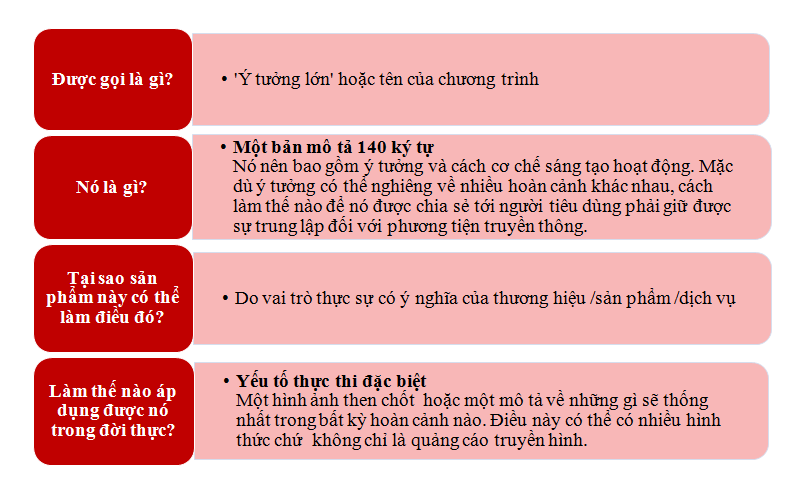
If we take the framework above and apply it to the belVita case study, it might look something like this:
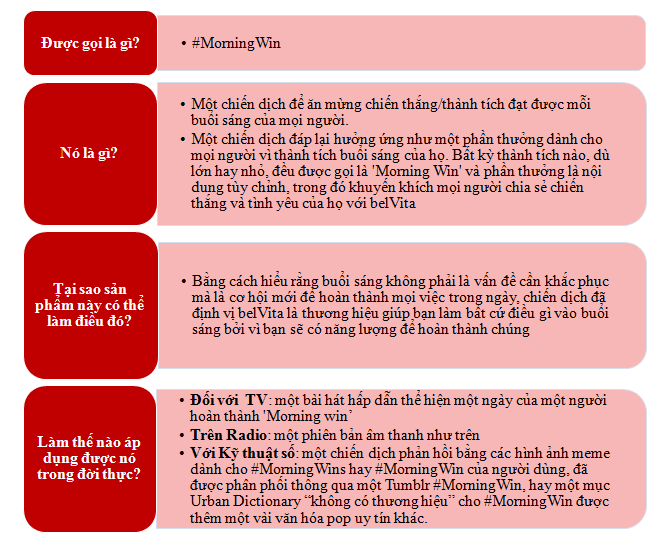
️ What is the name of the big idea?
#MorningWin
️ What is this big idea?
A campaign to celebrate everyone’s morning victories/achievements.
Any achievement, big or small, is called a “Morning Victory” and rewarded, encouraging everyone to share their victory and love for belVita.
️ Why does this product/service do it?
By understanding that the morning is not a problem to be fixed but a new opportunity to get things done, the campaign positioned belVita as the brand that helps you get anything done in the morning. Because you know you have the energy to do it.
️ What channels are used to spread the big idea?
- TV: a catchy commercial that represents a day in the life of someone who achieves “Morning Victory”
- Radio: an audio version of the advertisement on
- Digital: Real-time social response campaign to reward #MorningWins users; The #MorningWin meme image went viral through the hashtag #MorningWin on Tumblr; added the word #MorningWin to the pop culture dictionary.
With a big idea, belVita turned to execution, setting the ambitious goal of “owning from the morning”. To promote #MorningWin’s cultural fit and expand the campaign through culture, the brand created linked content across a range of channels, including TV, digital, radio and social media, as well as taking advantage of morning radio shows, Tumblr and Buzzfeed display relevant non-branded content according to the campaign’s theme.
The power of big ideas means creativity can span many facets, including a real-time response campaign that emphasizes both digital and physical rewards for #MorningWins due to User created:
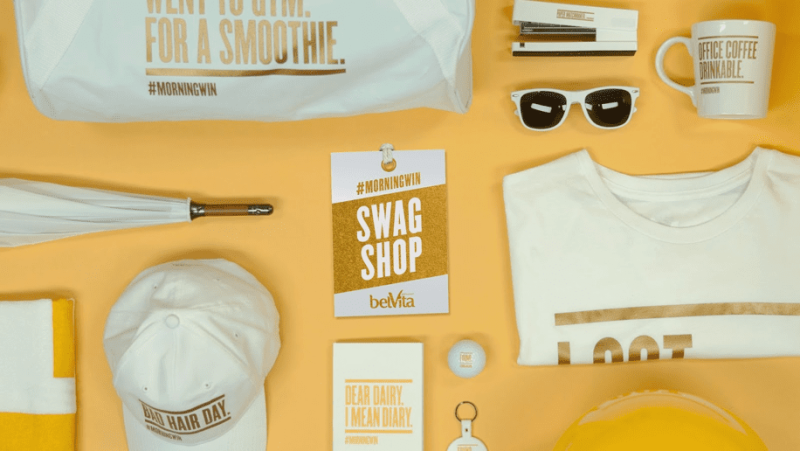
What are the notes when building a Big Idea?
1. Time
Creative thinking requires a lot of time to think and create an idea. At 3M, engineering teams allocate up to 15% of their time on projects of their choice.
IBM has “Think Fridays,” and Pixar employees can spend up to four hours a week engaging in non-work-related activities. Companies and service agencies, where time-to-invoice is critical, take up most of their time, so generating big ideas for financially savvy businesses can be a hurdle. big time barrier.
2. Mission
Creativity and effort need an end goal, and its goal is to build a “big idea”. Dove’s “True Beauty Campaign” is fueled by “Big Idea” which explicitly states that “the world would be a better place if Dove could make more women feel more beautiful every day”.
It creates a role to make more women feel better about themselves. By encouraging women to take more care of themselves, Dove has a positive impact on their self-esteem, helping to build a stronger association with the brand. This well-defined mission helps to release the amazing creations behind the “true beauty” initiatives.
3. Goals
Creativity needs a careful direction and clear direction and must know thoroughly what Big Idea is to come up with the right goal. Most successful companies have developed their own way of being able to immerse themselves in the world of their customers.
Lego – a toy company for children has taken ideas from customers most passionate about what to develop new products from. Crayola did a massive survey to really understand its target customers before embarking on a major product innovation, resulting in a manifesto that established who they were innovating and why.
Unilever has a “Consumer Nation” where employees experience what customers experience, tracked and then shared through lessons across the organization.

4. Technical
For the vast majority of creative marketers need a lot of factors in which developing together to produce “Big Ideas” is an advantage. There are many well-known techniques to help break established patterns and habits. Everything from brainstorming, generating structured ideas, filtering the most promising ideas and ideas. But here are some unusual examples:
- Teams at Facebook are free to move around their desks and furniture, join different groups to incubate fresh ideas, and creative spaces to promote new ideas to them.
- British Airways puts people on board – “an innovation test flight” – to solve the problem of upgrading the airline’s technology, to improve the user experience.
- More and more FMCG companies borrow from the IT world, adapting the “Hackathon model” to promote idea generation.
Factors you should focus on when building a Big Idea
Change
When you have any Big Idea, you can ask if your idea is of the nature to change common beliefs, ideas, conceptions or attitudes? Does it open up any breakthrough views or thoughts? Is it changing the perspective of customers, markets, companies and becoming a game changer on a massive scale?
If any of the above factors exist, then that’s a really cool idea. Its transformation is very likely to cause market effects (customers, prospects, competitors, influencers)
exclusivity
How closely can an idea tie in with your brand and just your brand? The intent behind exclusivity or ownership is: only us… just for you. For example, you cannot own the idea: “our company gathers the best people”. Your opponent can completely copy it at any time.
But with an idea like: “Our aerospace company was founded by the first two humans to land on the moon”, it is difficult to replicate.
Simplicity
When life has too many choices and things, I like to return to a simplified life. What is simpler but complete and convenient is also what impresses most consumers. One of the most outstanding bid ideas in this respect you can see the design of the Apple phone line
Originality
We are programmed to habitually and automatically ignore familiar focus and direct the laser to the new and original as we perform our usual routines. That is why a pedestrian on the street often notices an accident or even a new billboard along the road without any awareness. Brand marketers looking for Big Ideas are always looking to exploit this popular yet very powerful truth.
Surprise
Surprise is the cousin of originality. However, surprises are often irrational. It is closely related to a brand, which can mean raising the level of customer service in an industry where customers are always wrong so that customers feel appreciated and cared for. Good surprises make everyone feel special.
Contagiousness
Big ideas take customers to new things and they easily overlook your small mistakes. Maybe it’s a new song, taste, smell or solution… that becomes familiar to them.
Viral
Viral is more effective than viral. That’s when customers can’t sit still or not bring up your ideas in conversations. It has become a trend that people and families all aim for through channels such as word of mouth, through social networking channels such as Facebook, instagram, tiktok, etc.
>> Maybe you are interested: What is Viral Marketing?
Towards human individuality
It is human nature to be selfish. They do not care at all, find out if it does not concern them, does not affect their interests. You can study this point so that you can proceed with the attention-grabbing Big Idea implementation
Friendly
Campaigns need to focus on the element of friendliness and “kindness”. It can be campaigns about protecting the environment or providing customers with the most useful knowledge possible. In short, let’s put the customer’s interests first, solve their problems as well as give them a comfortable reception, towards the common good.
The secret to finding Big Idea when you have no idea – Big Idea in Marketing
When you understand what a big idea is and how to develop it, you still don’t know the most effective way to find a big idea, right?
Most of the time, the time when we sit down to come up with new marketing ideas is a pretty magical experience. It feels like we are camels carrying a lot of heavy loads on force and drawing very steep roads. But every once in a while, if we’re really lucky, we’ll experience a moment of reaching out to the sky, placing our hands in a torrent of creativity in the clouds.
Your first step in finding the best angle from which to sell your product is always to thoroughly research your topic. Take your research seriously, learn everything relevant to the topic. Once you’ve done your research, write down some possible Big ideas. If you’re ambitious, write down a basic outline, perhaps as a summary of how you’re going to change the status quo.
If the inspiration isn’t quite there yet, jot down a few general ideas, or some thoughts about your target market and how they can benefit from the product. Next, give yourself some space to get an insight that leads to the big idea. Here are the suggestions:
1. Allow your best friend plenty of time to rest
Put your work aside and go do something more fun. Take your dog for a walk, watch a movie at the theater, have coffee with friends, don’t think about the project or campaign you’re working on.
Our brains are still working on our copy, even when we take a break and do something completely unrelated. This time allows you to distance yourself from your own work, allowing you to make connections that would not be possible if you were just staring at your work and chewing the tip of a pen.
When you’re stuck on a great concept for your product, take a break and then come back to it. A ray of profound light may come in the middle of your resting void!
2. Collaborate with a diverse team
Some of the best creative work in the world is coming from companies that combine their cross-teams.
Try rotating positions from one group to another within your business, and you can get a more “fresh” look. This activity, if it happens often, will increase inventions or innovations. This is known as concept blending, and has been shown to work in a variety of situations.
Why use this technique in the process of finding the Big Idea? That’s because outsiders have a greater willingness to consider information and ideas that may not seem worth considering at first. Newcomers to the project will look at the analogies and related stages remotely, making unusual connections that people immersed in the problem often can’t.
So try hanging out in other groups of friends and discuss your questions for them. Ask them how you can market your product or service and what unusual and remarkable angle you can use.
3. Move your body
Swimming, jogging, yoga, lifting weights, etc. or any practice that regularly challenges you physically will also help you gain insight and make new connections.
Several successful people have shared that exercise is an important component of their creative process.
4. Don’t rush
Give yourself some time to think about your product, audience, and idea. If you give yourself only one day to come up with a big idea, you may fail. Give yourself space to entertain, play, incubate, grow and discuss things with other groups.
5. Traveling
If you can travel, get out of your home, city or even your country, you will be surprised at how creative your creativity will be. So think about getting your butt off the couch, going on a short or long trip. You will be amazed at what you see and idealize it in your Big idea.

Creating a big idea is not a simple task and involves many stages and stakeholders. Whether you’re generating an idea internally or collaborating with a department, it takes discipline and a clear focus on the campaign’s goal and summary.
Examples of Big Ideas of big brands
Going to Return – Biti’s Hunter
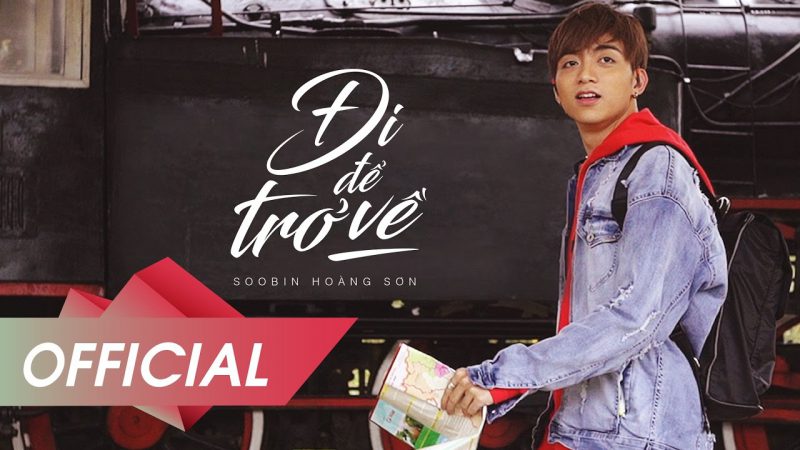
Biti’s launched a new product line Biti’s Hunter for young people who love to travel. The usual advertising of young people wearing Biti’s Hunter shoes and then going on a road trip lacks the emphasis in the media.
Therefore, Biti’s started to find insights of young audiences on social networks.
According to a survey by Biti’s, there are more than 87,000 conversations on the topic of “Go or Go” on social networks. In particular, during the Tet holidays, the story of traveling or returning to family is even more interested and debated by young people.
“If you go, you will come back. To go far, to discover, to experience, to grow more and to cherish the return, to cherish the return journey more. Go far to return!” is an expensive insight that Biti’s has gathered.
This is not only a campaign insight but is considered a platform insight, throughout season 1, season 2 and the following campaign seasons of Biti’s Hunter.
Vinacafe’s “Love into words” campaign with Big Idea “The cup of love”
Looking back on the past, the campaign “Love in words” launched by Vinacafe on Tet holiday in 2015 has also created great success. At that time, this was the advertising content that attracted the most attention on Youtube.
The campaign “Love in words” was implemented by Vinacafe to conquer the youth target group. Specifically, they are young people between the ages of 18-25, living in big cities, giving a lot of love to their parents but shy in expressing it in words. Meanwhile, parents are looking forward to the words “I love you dad”, “I love you mom”… from their children.

Case study of Vinacafe’s “Love in words” campaign with Big Idea “The cup of love” Through the “Love in words” campaign, Vinacafe wants to become an ambassador connecting parents and children. Through discovering the psychological truth of the target group, the big idea that is deployed throughout the entire campaign is “The cup of love”. Each set of Vinacafe products is accompanied by a cup of coffee with gentle and cute whispers and sentiments to their parents. For example, “Dad is difficult to approach, but I need it” or “Mother often complains but does everything for me”… Through that, Vinacafe has helped erase awkward moments between family members, helping they naturally express their love words to their loved ones.
Neptune cooking oil
Near the 2013 Lunar New Year, Neptune cooking oil launched an advertising TVC with the slogan “Going home to celebrate Tet, family first” and achieved very high communication efficiency. The main character of the advertisement is a deaf girl waiting for her father to come home to celebrate Tet with her family, but because he was busy with work, he could not return, she was very sad. When her grandfather gave her a lucky money, she ran back to the computer to signal her father. When watching the commercial, many people couldn’t help but be touched by the girl’s family affection.

The success of this ad is to hit the psychological and emotional factors. For thousands of years, Vietnamese people have always cherished good feelings, especially family love, which has contributed to moving the emotions of many people and creating the success of TVC. On the other hand, the time of launching TVC is close to the Lunar New Year, the time when those who are far away from home just want to come back home and spend the New Year with their families.
Advertisement of Vinamilk
Or Vinamilk’s advertisement, the image of animated dairy cows combined with funny songs really left an impression and resonated for a long time. Sometimes when walking on the road, we suddenly come across an image of a baby singing “Hundred percent, hundred percent. One hundred percent pure fresh milk,…”. That marks the first successful step in the process of promoting Vinamilk’s brand.
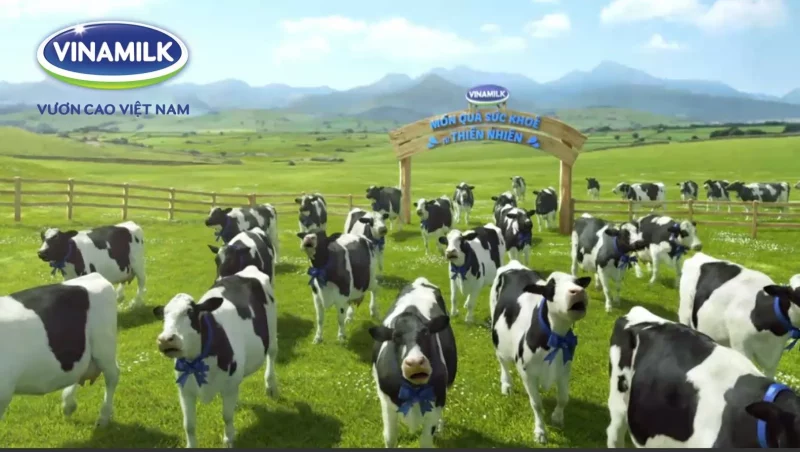
Vinamilk’s ads target children when the publisher uses cartoon images combined with music and children are the ones who often use fresh milk. When the children love it, the parents are ready to “pocket the wallet”.
Summary
To create a Big Idea is not an easy thing, Marketers always have to find strategies to create an advantage over competitors. Understanding what Big Idea is and coming up with great ideas is what every business wants and then creates a Marketing campaign as expected. Good luck!



